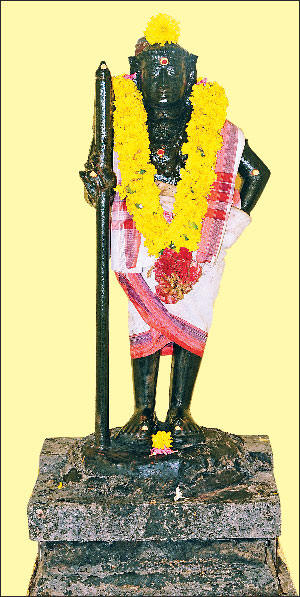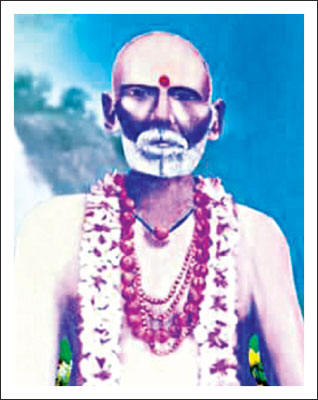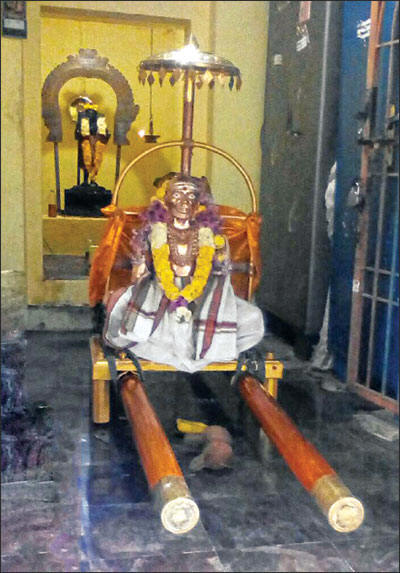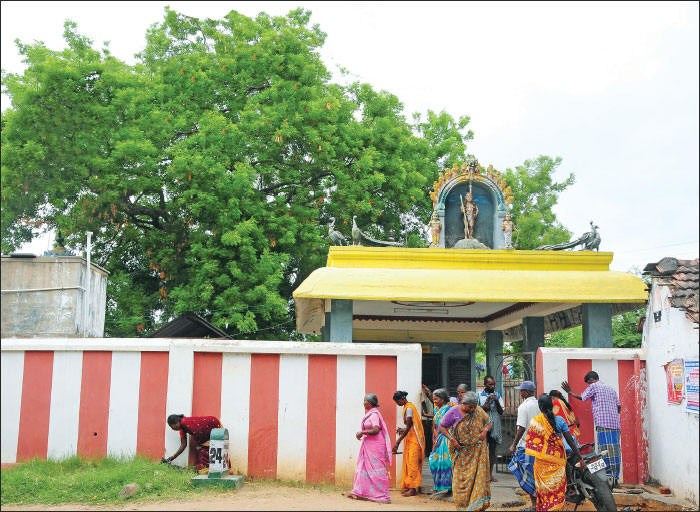009StaretsyDivineGrace
சக்தி விகடன் -
28 Aug, 2018
August 28, 2018 Sakthi Vikatan
திரு-அருள்-செல்வர்கள் = Divine-Grace-Staretsy
திருவருள் =
Divine Grace
திருவருள் செல்வர்கள்! –
9
Author:
பி.என்.பரசுராமன்.
P.N. Parasuraman
Starets Pazani Swamigal
Those are the formative years, that determines our future. The thirteenth year is critical. Many physiological, bodily and psychological changes take place at or around the 13th year. Tremendous changes greeted many boys and girls of this age, inclusive of good things. Kanchi Mahāswāmigaḷ became an ascetic at this age. 2
We will obtain Darśan of a Tiruvaruḷ Selvar (Starets endowed with Divine Grace) who at thirteen experienced and found several changes. 3

Rudrākṣa Mālai, a wide-open chest, a flower garland, splendorous ash stripes on the forehead reflecting the color of the soul, and a bald pate: A person walked the streets of Tiruvannamalai in his simple guise. 4
He was the 13-year-old Pazani Swāmigaḷ, adored and worshipped by the general public. Born and brought up in Pazani as an Avatara Puruṣa, he moved from Pazani to Tiruvannamalai prompted by his past life good deeds. This newcomer was not an overnight tourist but a devout servitor of Aruṇāchalēśvarar. “As many are hungry from lack of food, you fed me and protected me, my God. Aṇṇāmalai Āṇḍavā! What can I do in return?” That was his daily teary-eyed plea to Aruṇāchalēśvarar. 6
Making the circumambulation of the temple, he collected, disposed the trash and kept the temple clean. 7
Pazani Swāmigaḷ attracted people because of his youth, his simple appearance, his sacred temple service, and his soft-spoken nature. 8
Pazani Swāmigaḷ caught the eye of the ‘Youth of the Gopuram,’ the great ascetic. The townspeople called him ‘Reddiar Swāmigaḷ.’ Reddiar Swāmigaḷ’s sight was fixed on Pazani. 9
‘This young ascetic must be morphed into Siva’s servitor. His services must be praised by people for all times. Our plan must find completion. I must nourish and foster this young ascetic. ‘Thinking in such terms, Reddiar Swāmigaḷ invited Pazaniswāmy and came to know of his life history. 10
That is all it took! The Reddiar Swāmigaḷ ventured to put his plan in gear. What was that plan anyway? 11

Uneven grounds of these badlands were the feature in the temple complex. Reddiar wanted to make the Temple grounds even and beautiful. Moreover, a beautiful park should adorn the place. Where was he to go for people to do it? Was it an ordinary holy undertaking? 12
Reddiar had a plan for it too. Though he was in the ascetic guise, he felt many people were sleeping in Tiruvannamalai doing no physical work or service to the temple. “We can do the ministry and complete the work, still in the planning stages. We should not make them work free of wages. We should offer adequate and nutritious food and employ them.” Such were the thoughts and plans of Reddiar Swāmigaḷ. There were abundant ideas. Since the path to his views was not available, he was incubating his dreams and plans in peace and tranquility. 13
At the sight of Pazaniswāmy, Reddiar Swāmigaḷ’s mind and soul were suffused with joy. Exhilarated that his policies had the prospect of completion, he developed a confidence to accomplish his plans helped by Pazaniswāmigaḷ. Reddiar Swāmigaḷ believed that the servitors could be fed by doing Kāvaḍi (public charity of food grains) and entrusted the responsibility to Pazani swāmy. 14
How could Pazani Swāmigaḷ feed all the servitors doing the divine service? Pazaniswāmy was not disturbed at the prospect. ‘Who am I to undertake such a task? Aṇṇāmalaiappaṉ has chosen me to do this job. It is my job to do it with confidence, responsibility, dedication, and vigor. With that determination, he undertook the task. 15
He shouldered the Kāvaḍi with two vessels at the end of the poles. People dropped the food items in the vessels as much as they could afford. The resource to feed the servitors in the holy work took its debut. 16
Reddiar Swāmigaḷ handed over the responsibility and the accumulated wealth to Pazaniswāmy for uninterrupted holy service and shuffled off his mortal coil. 17
Though Pazaniswāmy was distressed by losing his friend and guide Reddiar, he took upon himself to complete the holy work as his gratitude and recompense to Reddiar Swāmigaḷ. He intensified his commitment and worked harder. The servitors did their utmost to carry out Pazaniswāmigaḷ’s suggestions. 18
The beautiful Temple gardens and the watering wells became a reality. The flowers accumulated as mountains. Many years passed by. Pazaniswāmigaḷ continued his divine service to the temple and cultivated and maintained the flower garlands for the temple. He built a flower hall where the flowers were sewn into garlands offered to the temple. The flower hall is between Iḷaiyanār Sannidhi and the Vaṉṉimara Piḷḷaiyār Temple. 19
One day, the servitors from Kāppaḷūr near Kalasappākkam invited Pazaniswāmigaḷ. He left the management of Nandavanam (garden) to a responsible person and went to Kāppaḷūr. Once he was there, the matter became apparent. 20
The inviting servitors took Pazaniswāmigaḷ to a ruined and dilapidated Siva Temple and told him the reason they invited him to Kāppaḷūr. 21

The servitors: “Swamy! If a man of your stature undertakes to rebuild this temple, the villagers and the outsiders will offer money for this project with confidence. The Temple renovation will continue with no interruption.” 22
Pazaniswāmigaḷ undertook the holy service of renovating the temple by offering a prayer and eulogy to Aṇṇāmalaiyār: “Aṇṇāmalaiappā! You chose me as the trusted servitor for this holy undertaking.” The servitors and Pazaniswāmy brought to completion the renovation of the temple, the sacred pond, and the flower garden. The villagers were wonder-struck. Swāmigaḷ handed over the maintenance work to the village servitors, offered them advice and returned to Tiruvannamalai. 23
Swāmigaḷ redoubled his effort in the expansion and maintenance of the temple gardens and the flower hall. Must you teach the honeybees to find the sweet sap of the flowers? Pazaniswāmy’s temple service news spread far and wide. Kanḍan, a servitor from Mēkkaḷūr south of Tiruvannamalai to him to his place. 24
He saw a pond in a rundown condition. He thought that renovating the lake would serve people for a long time. He approached the proper people, sought and received their help for the renovation of the lake. He completed the restoration of the lake and returned to Annamalai. 25
When Swāmigaḷ was doing the Temple service, with no regard to night and day, he used to saunter in the area where subterranean Lingam was present. No one ever went there. 26
One day he heard an audible harsh breathing sound. Could that be a hissing snake? He went inside with a friend. 27
A Bālayōgi was seen seated leaning on the wall. He looked weak and famished. Swāmigaḷ understood that it was his breathing that attracted his attention. They helped the Bālayōgi come to ground level, gave him a bath and replaced his loincloth. 28
Bhagavāṉ Srīramaṇar was the child ceremoniously brought out from the subterranean chamber to the outside world. Pazaniswāmy was the discoverer of Srīramaṇar performing Yoga near the Pātāla Liṅgam. 29

After the rescue of Bālayōgi, and yielding to the supplication of servitors of Avalūr Pēṭṭai, he stayed at the Moṭṭaip-Piḷḷaiyār Temple. His services are incomparable. 30
He faced four acres of badlands. He rehabilitated those lands into cultivable lands and planted a grove. He maintained the temple pujas from the income from the orchard. As usual, he fed the servitors by Kāvaḍi and took care of their welfare. 31
There was no telling how many temples, temple gardens and sacred ponds and lakes he helped renovate. To honor him is to maintain them. Then, the water shortage would not be a problem. 32
We not only forgot about the Staretsy (TiruvaruḷSelvarkaḷ = திருவருள்செல்வர்கள் = Divine-Grace-Staretsy) but also ruined their divine selfless service projects. Let the past be past and gone. The rainy season is imminent. Let us remember Pazaniswāmy, His Divine Grace Starets and take care of the lake, pond, and well. 33
Pazaniswāmy lived for selfless divine service. He attained the holy feet of Sivaperuman in 1929: Raktākṣi Tamil year, the month of Māragazi, waxing moon, Chitrai Nakṣatra. His Samadhi temple and regular services are in place at Avalūr Pēṭṭai. 34
The well-wishers and the interested may very well go to Avalūr Pēṭṭai and receive his Divine Grace. Your life will be enriched.
Divine Grace will flow.
Images: K. Murali